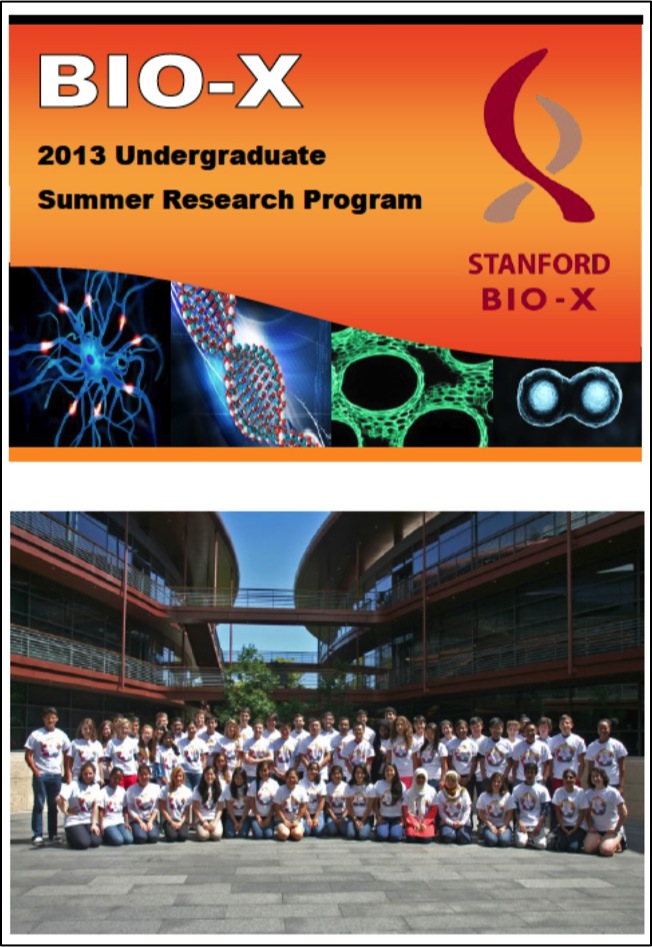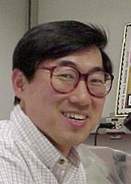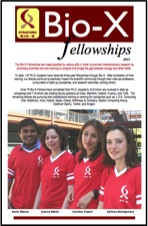
Welcome to the biweekly electronic newsletter from Stanford Bio-X for members of the Bio-X Corporate Forum. Please contact us if you would like to be added or removed from this distribution list, or if you have any questions about Stanford Bio-X or Stanford University.
10th Anniversary of the James H. Clark Center, the hub of Bio-X. Check out CLARK CENTER @ 10X on the SPLASH PAGE as well as the Bio-X Timeline over the last 15 years!!
President's Column
A Cauldron of Innovation - The Clark Center has incubated pathbreaking inventions and transformed our thinking - article by Stanford President John Hennessy in the Nov/Dec 2013 issue of the Stanford Magazine on Bio-X and the Clark Center
Seed Grants
 SEED GRANTS FOR SUCCESS - Stanford Bio-X Interdisciplinary Initiatives Program (IIP)
SEED GRANTS FOR SUCCESS - Stanford Bio-X Interdisciplinary Initiatives Program (IIP)
The Bio-X Interdisciplinary Initiatives Program represents a key Stanford Initiative to address challenges in human health. The IIP awards approximately $3 million every other year in the form of two-year grants averaging about $150,000 each. From its inception in 2000 through the fifth round in 2010, the program has provided critical early-stage funding to 114 different interdisciplinary projects, involving collaborations from over 300 faculty members, and creating over 450 teams from five different Stanford schools. From just the first 5 rounds, the IIP awards have resulted in a 10-fold-plus return on investment, as well as hundreds of publications, dozens of patents filed, and most importantly, the acceleration of scientific discovery and innovation.
In 2012, Stanford Bio-X selected 23 new seed grant projects as the winners of the 6th round. Please go here to view the list of awardees, along with the titles of their projects and the abstracts of the research. Competition was intense as the awardees were chosen from 118 Letters of Intent (LOIs). Selection criteria included innovation, high-reward, and interdisciplinary collaboration. (To view the 114 other IIP projects that have been funded from the first 5 rounds, please click here.) In addition, SANOFI has also funded 4 new Bio-X IIP Seed Grant projects from round 6!
On Monday, August 26, 2013, Bio-X had its second annual IIP Symposium of the year at the Clark Center, which highlights projects that exemplify the Stanford Bio-X mission of crossing boundaries to bring about interdisciplinary research and solutions in the field of life bioscience. The symposium was a huge success with over 300 people attending this event, which included 8 oral presentations and 136 poster presentations. Recorded talks from the symposium will be uploaded soon. If you'd like to view the talks for previous symposia through the years, please click here.
We are cultivating and are highly successful in building meaningful collaborations with numerous corporate colleagues. New collaborations through our seed grant projects are highly encouraged. To learn about how to get involved, please contact Dr. Hanwei Li or Dr. Heideh Fattaey.
Fellowships
Every year, graduate students and postdoctoral scholars of Bio-X affiliated faculty are highly encouraged to apply for the Bio-X Fellowships, which are awarded to research projects that are interdisciplinary and utilize the technologies of different fields to solve different biological questions. Students are encouraged to work collaboratively with professors of different departments, thus creating cross-disciplinary relationships among the different Stanford schools. Our fellows have conducted exciting research, resulting in publications in high-impact journals and have been offered excellent positions in industry and academia. To date, Stanford Bio-X has a total of 152 Fellows.
On June 26th, Bio-X held its annual Bio-X Fellows Symposium, where there were four 15-minute oral presentations followed by one-minute spiels from current fellows. The 25 newest fellows selected this year were also announced, and about 100 attendees came to the symposium. Please click on the "Bio-X Fellows Symposium" link above for the agenda and titles of the talks, and on the icon of the brochure above for the updated and latest Bio-X Fellowships brochure.
To view the numerous projects that have been awarded over the years, please click here.
 BIO-X UNDERGRADUATE SUMMER RESEARCH PROGRAM
BIO-X UNDERGRADUATE SUMMER RESEARCH PROGRAM
The Bio-X Undergraduate Summer Research Program supports undergraduate research training through an award designed to support interdisciplinary undergraduate summer research projects. The program is an invaluable opportunity for students to conduct hands-on research, learn how to carry out experiments in the laboratory, and develop the skills to read and analyze scientific literature.
This program is eligible to Stanford students who want to work in the labs of Bio-X affiliated faculty. To date, 241 students have been awarded the opportunity to participate in the Bio-X Undergraduate Summer Research Program. This summer is Stanford Bio-X's 8th round of USRP.
Participating undergraduates are also required to present poster presentations on the research that they've conducted during the program. Please click here for title lists of past posters that our undergraduates have presented.
Many fruitful collaborations and relationships have been established with industry through fellowships. Please contact Dr. Hanwei Li or Dr. Heideh Fattaey if you'd like to learn more about how to get involved with these fellowship programs.
News
 Scientists think mysterious virus could be a signal of a weak immune system
Scientists think mysterious virus could be a signal of a weak immune system
Bio-X Affiliated Faculty Stephen Quake
More than 260,000 Americans are alive today thanks to transplant operations that have replaced their failing kidneys, hearts, lungs or livers with healthy organs donated by volunteers or accident victims. But treatment doesn’t end with surgery. Transplant recipients follow strict drug regimens designed to suppress their immune systems just enough to prevent rejection of the donated organ, but not so much as to leave them prone to infection. Until now, maintaining this delicate balance has been something of a medical guessing game. But in a study published Nov. 21 in Cell, Stanford University scientists report the discovery of what may be a barometer of immune-system strength: a little-known virus that proliferates as the medications suppress the immune system. The work was led by senior author Stephen Quake, PhD, the Lee Otterson Professor in the School of Engineering and professor of bioengineering and of applied physics.
 Common brain cell plays key role in shaping neural circuits, study finds
Common brain cell plays key role in shaping neural circuits, study finds
Bio-X Affiliated Faculty Ben Barres
Stanford University School of Medicine neuroscientists have discovered a new role played by a common but mysterious class of brain cells. Their findings, published online Nov. 24 in Nature, show that these cells, called astrocytes because of their star-like shape, actively refine nerve-cell circuits by selectively eliminating synapses — contact points through which nerve cells, or neurons, convey impulses to one another — much as a sculptor chisels away excess bits of rock to create an artwork. “This was an entirely unknown function of astrocytes,” said Ben Barres, MD, PhD, professor and chair of neurobiology and the study’s senior author. The lead author was Won-Suk Chung, PhD, a postdoctoral scholar in Barres’ lab. More than one-third of all the cells in the human brain are astrocytes. But until quite recently, their role in the brain has remained obscure. The study was performed on brain tissue from mice, but it is likely to apply to people as well, Barres said. The discovery adds to a growing body of evidence that substantial remodeling of brain circuits takes place in the adult brain and that astrocytes are master sculptors of its constantly evolving synaptic architecture. The findings also raise the question of whether deficits and excesses in this astrocytic function could underlie, respectively, the loss of this remodeling capacity in old age or the wholesale destruction of synapses that erupts in neurodegenerative disorders, such as Alzheimer’s and Parkinson’s disease.
 Inflammatory skin damage in mice blocked by bleach solution, study finds
Inflammatory skin damage in mice blocked by bleach solution, study finds
Bio-X Affiliated Faculty Seung Kim
Processes that age and damage skin are impeded by dilute bleach solution, according to a new study by researchers at the Stanford University School of Medicine. The study was conducted on mice. But if shown to work similarly in humans, the inexpensive, widely available household chemical could provide a new way to treat skin damage caused by radiation therapy, excess sun exposure or aging. Dilute bleach baths have been used for decades to treat moderate to severe eczema in humans, but it has not been clear until now why they work. “Originally it was thought that bleach may serve an antimicrobial function, killing bacteria and viruses on the skin,” said Thomas Leung, MD, PhD, an instructor in dermatology at Stanford and a pediatric dermatologist at Lucile Packard Children’s Hospital. “But the concentrations used in clinic are not high enough for this to be the sole reason. So we wondered if there could be something else going on.” Leung is the lead author of the study, which will be published online Nov. 15 in the Journal of Clinical Investigation. Seung Kim, MD, PhD, professor of developmental biology and a Howard Hughes Medical Institute investigator, is the study’s senior author. “Dr. Leung relentlessly followed his hunch that an antimicrobial effect of dilute bleach wasn’t the whole story,” Kim said. “And his work has revealed new mechanisms for targeting inflammatory pathways with this versatile small molecule. It has also identified new possible clinical applications.”
 Size, connectivity of brain region linked to anxiety level in young children, study shows
Size, connectivity of brain region linked to anxiety level in young children, study shows
Bio-X Affiliated Faculty Vinod Menon
Prolonged stress and anxiety during childhood is a risk factor for developing anxiety disorders and depression later in life. Now, Stanford University School of Medicine researchers have shown that by measuring the size and connectivity of a part of the brain associated with processing emotion — the amygdala — they can predict the degree of anxiety a young child is experiencing in daily life. They found that the larger the amygdala and the stronger its connections with other parts of the brain involved in perception and regulation of emotion, the greater the amount of anxiety a child was experiencing. The findings do not mean that a young child with an enlarged and highly connected amygdala will necessarily go on to develop a mood disorder, said Vinod Menon, PhD, professor of psychiatry and behavioral sciences and senior author of the study, published online Nov. 20 in Biological Psychiatry. “We are not at a point where we can use these findings to predict the likelihood of a child developing mood and anxiety disorders as an adult, but it is an important step in the identification of young children at risk for clinical anxiety,” Menon said.
 Listen to this: Research upends understanding of how humans perceive sound
Listen to this: Research upends understanding of how humans perceive sound
Bio-X Affiliated Faculty Anthony Ricci
A key piece of the scientific model used for the past 30 years to help explain how humans perceive sound is wrong, according to a new study by researchers at the Stanford University School of Medicine. The long-held theory helped to explain a part of the hearing process called “adaptation,” or how humans can hear everything from the drop of a pin to a jet engine blast with high acuity, without pain or damage to the ear. Its overturning could have significant impact on future research for treating hearing loss, said Anthony Ricci, PhD, the Edward C. and Amy H. Sewall Professor of Otolaryngology and senior author of the study. “I would argue that adaptation is probably the most important step in the hearing process, and this study shows we have no idea how it works,” Ricci said. “Hearing damage caused by noise and by aging can target this particular molecular process. We need to know how it works if we are going to be able to fix it.” The study was published Nov. 20 in Neuron. The lead author is postdoctoral scholar Anthony Peng, PhD.
Events
| Cardiovascular Institute November 26, 2013, 12 pm - 1 pm LKSC-130, Stanford, CA Frontiers in Cardiovascular Science: "Role of the Late Sodium Current in the Electro-Mechanical Dysfunction of Human Hypertrophic Cardiomyopathy" Speaker: Luiz Berlardinni, Gilead |
Pathology November 26, 2013, 12:30 pm - 1:30 pm LKSC-120, Stanford , CA "Microsatellite unstable colorectal cancer" Speaker: Wendy L. Frankel, MD, Ohio State Univ Med |
| Neurology & Neurosciences December 2, 2013, 4 pm - 5 pm Clark Center Auditorium, Stanford, CA Frontiers in Aging Seminar Series: "Aging and cancer: Rival demons?" Speaker: Judith Campisi, PhD, Buck Institute for Research on Aging |
Biochemistry December 4, 2013, 4 pm - 5 pm Clark Center Auditorium, Stanford, CA Frontiers in Biology: "Some assembly required: molecular mechanisms for building a replisome" Speaker: James Berger, UCB |
Resources
| Stanford University |
| Stanford Bio-X |
| Bio-X Seed Grants The Stanford Bio-X Interdisciplinary Initiatives Program (IIP) provides seed funding for high-risk, high-reward, collaborative projects across the university, and have been highly successful in fostering transformative research. |
| Office of Technology and Licensing "Techfinder" Search the OTL Technology Portal to find technologies available for licensing from Stanford. |
| Stanford Center for Professional Development - Take advantage of your FREE membership! - Take online graduate courses in engineering, leadership and management, bioscience, and more. - Register for free webinars and seminars, and gets discounts on courses. |
| Stanford Biodesign Video Tutorials on how FDA approves medical devices A series of video briefs recently produced by the Stanford Biodesign Program teaches innovators how to get a medical device approved for use in the United States. This free, online library of 60 videos provides detailed information on the Food and Drug Administration regulatory process, short case studies and advice on interacting with the FDA. |
To learn more about Stanford Bio-X or Stanford University, please contact Dr. Hanwei Li, the Bio-X Corporate Forum Liaison, at 650-725-1523 or lhanwei1@stanford.edu, or Dr. Heideh Fattaey, the Executive Director of Bio-X Operations and Programs, at 650-799-1608 or hfattaey@stanford.edu.


